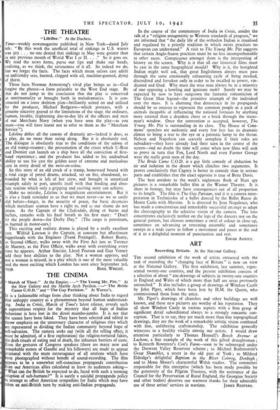THE CINEMA
` March of Time." At the Empire.—" The Young Mr. Pitt." At the New Gallery and the Marble Arch Pavilion.—" The Bride Came C.O.D." and " The Gay Parisian." At Warner's.
r is a fashionable refuge from clear thinking about India to regard at unhappy country as a phenomenon beyond human understand- ing. India in Crisis, March of Time's latest release, reveals such superstitious respect for the mystery that all logic of Indian behaviour is here lost in the direst mumbo-jumbo. It is not that e scenes have been faked. They have been selected and edited to ow emphasis on the unsavoury character of religious rites which e represented as dividing the Indian community beyond hope of If-salvation. The camera seeks out (with all the telling effect, it ust be admitted, of a first exploration) the religion-tortured fakirs, e drab rituals of eating and of death, the inhuman barriers of caste. ven the gestures of Congress speakers (there are many new and remarkable scenes of Gandhi and his followers) are made to appear rational with the mute extravagance of all orations which have en photographed without benefit of sound-recording. The film Ppears to be a somewhat self-conscious propaganda contribution tom our American allies calculated to leave its audiences asking- " What can the British be expected to do, faced with such a teeming eruption of sub-humans?" It is surely a suicidal propaganda policy o attempt to offset American sympathies for India which may have aken an anti-British turn by making anti-Indian propaganda. In the course of the commentary of India in Crisis, amidst the talk of a "religion antagonistic to Western standards of progress," we are informed that " the daily life of the orthodox Indian is ritualised and regulated by a priestly tradition in which exists practices no European can understand." A visit to The Young Mr. Pitt suggests that certain Anglo-Saxon practices must be no less incomprehensible to other races. Conspicuous amongst them is the interpreting of history on the screen. Why is it that all our historical films must be cast in the same biographical mould? Why is it, the benighted Indian might well ask, that great Englishmen always must pass through the same emotionally exhausting cycle of being mocked, discredited and forsaken only in order to be recalled to power, vin- dicated and feted. Why must the wise man always be in a minority of one opposing a howling and ignorant mob? Surely we may be expected by now to have outgrown the fantastic romanticism of The Great Man legend—the primitive triumph of the individual over the mass. It is alarming that democracy in its propaganda should be so anxious to represent the common people as a pack of animals incapable of influencing the national fortunes by anything more rational than a drunken cheer or a brick through the states- man's window. Once the convention is accepted, however, The Young Mr. Pitt is outstanding in its class. The House of Com- mons' speeches are authentic and every few feet has its dramatic climax to bring a tear to the eye or a patriotic lump to the throat. Nelson and Napoleon can scarcely complain if their roles are subsidiary—they have already had their turn in the centre of the screen—and no doubt the time will come when new films will seek to prove in turn that Fox, Lord North and even Farmer George were the really great men of the day.
The Bride Came C.O.D. is a gay little comedy of abduction by air and isolation in the desert which clinches two arguments. It proves conclusively that Cagney is better in comedy than in serious parts and establishes that the exact opposite is true of Bette Davis.
The best antidote to the week's nightmare flock of Nazi spy pictures is a remarkable ballet film at the Warner Theatre. It is short in footage, but may have consequences out of all proportion to its length. The film is The Gay Parisian, and it is a camera inter- pretation in Technicolor of a ballet danced by the Ballet Russe de Monte Carlo with. Massine. It is directed by Jean Negulesco, who has made a conscientious and remarkably successful attempt to adapt the choreography to the selective vision of the camera. The lens concentrates exclusively neither on the legs of the dancers nor on the general pattern, but chooses sometimes a swirl of colour in close-up, sometimes an advancing or retreating ensemble and sometimes sweeps in a wide curve to follow a movement and pause at the end of it in a delightful moment of punctuation and rest.
EDGAR ANSTEY.


























 Previous page
Previous page